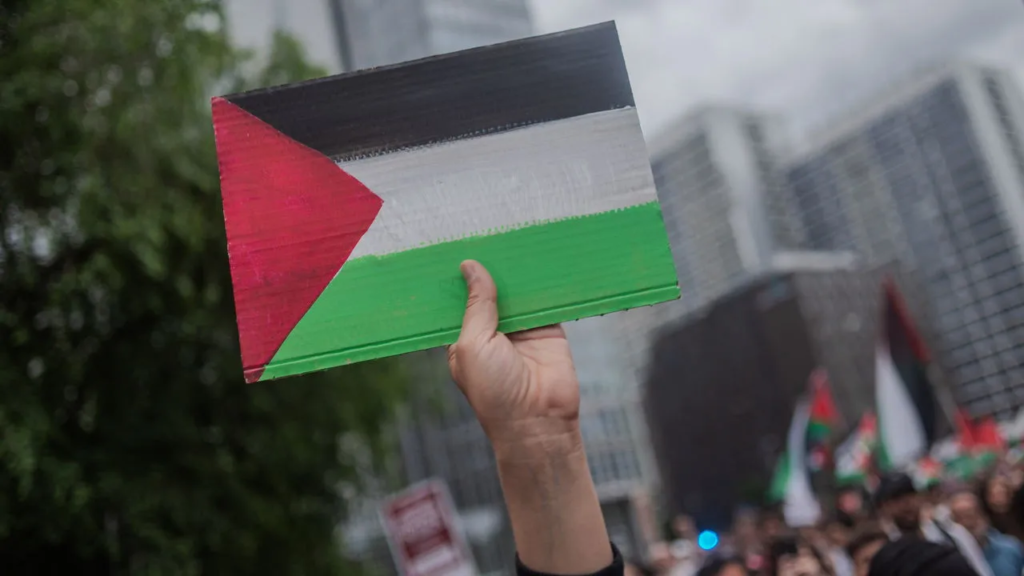
The flag of Palestine is one of the most recognizable and significant symbols in the world today. It carries deep historical, cultural, and political meaning for Palestinians and has become a global symbol of resistance, hope, and the quest for justice. The flag is more than just a piece of cloth; it represents a nation’s identity, its past, and its aspirations for a future of peace and independence. In this article, we will explore the flag of Palestine’s meaning, its history, the symbolism behind its colors, and its role in the ongoing Palestinian struggle for self-determination.
Understanding the Flag of Palestine
The flag of Palestine consists of three horizontal stripes, a red triangle on the left side, and a distinctive color scheme of black, white, green, and red. These elements together create a powerful visual representation of Palestinian nationalism and the struggle for an independent state. The flag is not just a symbol but also a tool for expressing political solidarity, identity, and pride.
The design of the Palestinian flag is rooted in the Pan-Arab colors, which are significant in the context of the broader Arab world. These colors were adopted by various Arab countries as a representation of Arab unity and the shared history of the region. However, in the case of Palestine, the flag’s meaning goes beyond regional symbolism, and it has become intrinsically tied to the Palestinian people’s struggle for freedom, independence, and recognition as a sovereign nation.
The History of the Flag of Palestine
The flag of Palestine has evolved over time, reflecting the changing political landscape and the aspirations of the Palestinian people. Its origins can be traced back to the early 20th century, during the period of British rule in Palestine, and the flag has undergone various iterations before arriving at its current design.
Early Beginnings
The first use of the flag of Palestine dates back to the early 1920s, during the period of the British Mandate in Palestine. The Palestinian flag was not officially recognized at that time but was used as a symbol of Palestinian identity by nationalist movements. In 1920, the flag was first flown during the Syrian-Palestinian Congress. This early design was different from the modern flag, but it marked the beginning of the struggle for Palestinian independence.
In 1947, after World War II and the partition plan by the United Nations, the flag of Palestine became associated with the Palestinian Arab national movement. However, the flag continued to evolve in the face of changing political circumstances and the ongoing conflict between the Palestinian Arabs and the Zionist movement.
The Flag After 1948

After the establishment of the state of Israel in 1948 and the subsequent Arab-Israeli War, the Palestinian people were displaced, and their territory was divided. Despite this, the Palestinian flag continued to represent the aspirations of the Palestinian people for independence and self-determination. The flag was used by various Palestinian political organizations, including the Palestinian Liberation Organization (PLO), which was founded in 1964.
In 1964, the PLO adopted the flag as its official flag, which included the three horizontal stripes (black, white, and green) and the red triangle. The flag was intended to symbolize the unity of the Palestinian people and their struggle against foreign occupation. It became the symbol of the Palestinian national movement and has remained in use ever since.
The Flag Today
The Palestinian flag continues to be a symbol of resistance and national pride for Palestinians both in the occupied territories and in the diaspora. It is flown at protests, political rallies, and international events as a sign of solidarity with the Palestinian cause. The flag also plays an important role in Palestinian diplomacy, as it is often displayed in the offices of Palestinian representatives and embassies around the world.
Despite the challenges and obstacles that Palestinians face, the flag of Palestine remains a potent symbol of their enduring struggle for freedom and justice. It is seen as a symbol of hope for a future Palestinian state, one that can coexist peacefully with its neighbors and secure the rights and dignity of its people.
The Symbolism of the Colors in the Flag of Palestine
The colors of the Palestinian flag are rich with meaning and reflect the history, heritage, and struggles of the Palestinian people. Each color has its own significance, which ties into the broader narrative of Palestinian identity and the national movement. The flag’s colors—black, white, green, and red—are known as the Pan-Arab colors, and they have been used by various Arab countries as symbols of unity and solidarity. However, in the case of Palestine, these colors carry deeper layers of meaning.
Black: The Dark Past and Struggle for Liberation
The black stripe in the flag represents the dark period of Palestinian history, particularly the period of colonialism and foreign occupation. It symbolizes the struggles that the Palestinian people have endured over the centuries, from the Ottoman Empire’s rule to the British Mandate, and the ongoing Israeli occupation of Palestinian territories. Black also represents the desire to overcome oppression and the quest for liberation from foreign rule. It is a color that reflects the pain and suffering of the Palestinian people but also their resilience in the face of adversity.
White: Peace and the Vision for a Better Future
The white stripe in the flag represents peace and the hope for a future where the Palestinian people can live in freedom and security. It symbolizes the Palestinian aspiration for a just and lasting peace with their neighbors, particularly Israel. The white also signifies the purity of the Palestinian cause, rooted in the principles of justice, human rights, and self-determination. Palestinians continue to seek peace through negotiations and diplomacy, while at the same time holding on to the belief that justice will ultimately prevail.
Green: The Land and the Connection to the Earth
Green is a symbol of the land of Palestine, its fertile soil, and its rich agricultural heritage. It represents the deep connection that Palestinians have with their homeland, as well as their desire to preserve the land for future generations. The color green also symbolizes prosperity, growth, and hope for a brighter future. It reflects the Palestinian people’s determination to rebuild their communities and create a thriving, peaceful state. In the context of the flag, green is a reminder of the beauty and importance of the land, and it highlights the Palestinian people’s strong attachment to it.
Red: The Struggle and Sacrifice
The red triangle on the flag is a symbol of the sacrifices made by Palestinians in their struggle for independence. Red represents the blood that has been shed by countless individuals who have fought and died for the cause of Palestinian freedom. It also signifies the passion and determination of the Palestinian people to achieve their goals, regardless of the challenges they face. The color red is associated with resistance, courage, and the unwavering commitment to securing a better future for the Palestinian people.
The Flag of Palestine and Its Role in Global Solidarity

The flag of Palestine is not only a national symbol but also a symbol of global solidarity. Over the years, it has become an emblem of support for the Palestinian cause, as people from all over the world have rallied behind the Palestinian people in their fight for justice and self-determination. The flag has been flown at demonstrations, protests, and events around the world, signaling solidarity with the Palestinian struggle.
In addition to grassroots support, the flag of Palestine has also gained recognition in international forums. The United Nations General Assembly granted Palestine non-member observer state status in 2012, and the Palestinian flag was officially raised at the UN Headquarters in New York in 2015. This moment marked a significant step in the recognition of Palestine as a sovereign entity on the world stage. While the political situation remains complex, the global recognition of the Palestinian flag is a testament to the enduring power of the Palestinian people’s aspirations for freedom and justice.
The Flag in Palestinian Identity and Culture
For Palestinians, the flag is not just a political symbol; it is an important part of their cultural and national identity. It is a constant reminder of the collective struggle for self-determination and the deep connection to the land. The flag is often seen in Palestinian homes, schools, and community centers, symbolizing pride and unity.
The flag also plays a central role in Palestinian art, literature, and music. Many Palestinian artists incorporate the flag’s colors and imagery into their works, using them as symbols of resistance and national pride. Songs of protest and freedom often include references to the flag, and it is featured in Palestinian literature as a powerful representation of the nation’s aspirations.
Conclusion
The flag of Palestine is more than just a national symbol; it is a representation of the Palestinian people’s enduring struggle for freedom, justice, and self-determination. Its colors—black, white, green, and red—carry deep meaning, each symbolizing different aspects of Palestinian history, culture, and aspirations. Over the years, the flag has become a powerful symbol of unity, hope, and resistance, not just for Palestinians but for people around the world who stand in solidarity with their cause.
Despite the challenges and obstacles that continue to face the Palestinian people, the flag of Palestine remains a beacon of hope for a better future. It is a reminder of the resilience of a nation and its people, who continue to strive for peace, dignity, and independence. As long as the flag flies, the spirit of the Palestinian struggle will endure, inspiring generations to come.


